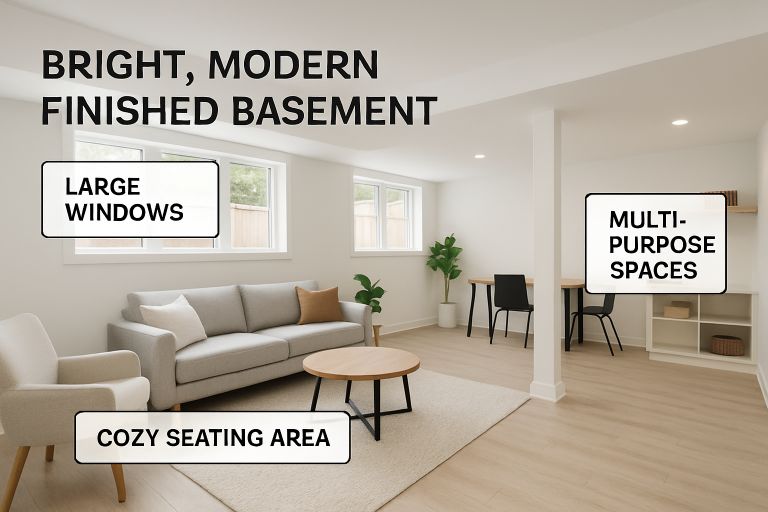Home Improvement
Basement Finishing Tips for Modern Homes
Key Takeaways
- Address waterproofing and moisture control first for a long-lasting result.
- Enhance natural light and incorporate flexible design elements for both form and function.
- Integrate energy-efficient, modern, and code-compliant systems.
- Balance lighting, soundproofing, and contemporary finishes for superior comfort.
Modern homeowners are reimagining their basements, transforming them from underutilized storage zones into vibrant, multi-purpose spaces. Whether you envision a family retreat, a sleek home gym, or a state-of-the-art office, a finished basement can significantly enhance both your property value and quality of life. If you’re considering a basement walk out in Potomac Falls, VA, you’ll want to incorporate thoughtful planning and design for livability, style, and durability.
In today’s market, trends favor light-filled, flexible spaces that accommodate changing family needs. Moisture management, energy efficiency, and code compliance remain at the forefront of every successful basement project, ensuring your investment stands the test of time. Embrace current design elements to produce a space that feels timeless, not just trendy.
From the first inspection to final finishes, these essential tips will help you create a beautiful, comfortable, and functional basement that truly enhances your home. Let these insights serve as your blueprint for an exceptional renovation process.
Homeowners often overlook the importance of space versatility and lighting, yet these can make or break the usability of your finished basement. Determining your priorities early in the process will ensure each design choice serves both your current and future lifestyle.

Prioritize Waterproofing
Strong basement design starts with a dry, sealed foundation. Inspect for cracks or water intrusion before any renovation work. Apply waterproof sealants on walls and floors, and consider adding a sump pump if your area is prone to flooding. Closed-cell foam insulation offers enhanced moisture resistance, helping to regulate temperature while keeping out moisture. Regular maintenance of gutters, downspouts, and exterior grading is essential for supporting interior waterproofing and protecting your renovation investment.
Maximize Natural Light
Basements typically lack natural daylight, so creative strategies are key. Install egress windows for light and safety, or optimize window wells to let more sunlight into below-grade rooms. Glass doors and strategically placed interior mirrors help distribute existing light, making the space feel more open and less subterranean. Consider LED daylight bulbs for additional brightness wherever structural changes aren’t possible.
Design Multi-Functional Spaces
Flexible, open layouts cater to evolving needs—think a guest suite that doubles as a playroom, or a den that transitions to a home theater. Room dividers, sliding panels, and modular furniture enable easy reconfiguration without compromising the space. Plan for both private and communal uses, and place sound-dampening barriers where needed to ensure maximum comfort and privacy for all activities.
Choose Energy-Efficient Solutions
Energy efficiency plays a central role in modern renovations. Radiant floor heating and ductless mini-split HVAC systems are quiet, effective ways to control basement temperatures while reducing utility bills. Smart thermostats and zoning features enable you to tailor heating and cooling to your occupancy and preferences, optimizing comfort and savings. For more tips and guidelines on designing an energy-efficient home, you can explore resources from the U.S. Department of Energy.
Investing in energy-efficient solutions not only lowers monthly expenses but also contributes to a more sustainable lifestyle. Over time, these upgrades can increase your home’s value and appeal to future buyers who prioritize efficiency.
Ensure Compliance with Building Codes
Renovating below grade comes with exceptional safety and legal considerations. Obtain permits and consult with local authorities to confirm compliance regarding egress, ceiling height, fire-rated materials, and electrical/plumbing standards. Adhering to all regulations not only keeps your home safe but can also affect future resale value and insurance eligibility. For a comprehensive guide on basement finishing rules and best practices, refer to This Old House. Additionally, planning for ventilation and moisture control can help prevent long-term issues such as mold and structural damage. Investing in quality materials and professional installation ensures your basement is both functional and durable.
Incorporate Modern Design Elements
Opt for a minimalist palette and sleek, high-end finishes that lend a contemporary edge. Polished concrete, matte black hardware, and open shelving foster a sense of spaciousness and modernity. Use texture—such as exposed beams or wood accents—for warmth and contrast against smooth surfaces. Keep sightlines open by avoiding bulky built-ins or heavy furnishings, which can make basements feel smaller.
Plan for Adequate Lighting
Layer ambient, task, and accent lighting to create a welcoming environment at any hour. Recessed LED fixtures reduce overhead clutter, while wall sconces and under-cabinet lights illuminate workspaces and seating nooks. Light-colored walls, ceilings, and reflective accents further amplify the sense of brightness.
Address Soundproofing Needs
High-activity basements benefit from enhanced sound insulation. Use batt insulation between floor joists and resilient channels when hanging new drywall to minimize noise transfer from upstairs. Carpeting, area rugs, and acoustic ceiling tiles can absorb echoes, keeping entertainment or music zones from disturbing the rest of the house. Designing for acoustic comfort improves the enjoyment of every activity, from home theaters to late-night entertaining.
When thoughtfully finished, your basement becomes much more than extra square footage—it’s a dynamic, integral part of your home. Tailor each design choice to your lifestyle and enjoy the rewards of a functional, beautiful, and high-value space for years to come.














